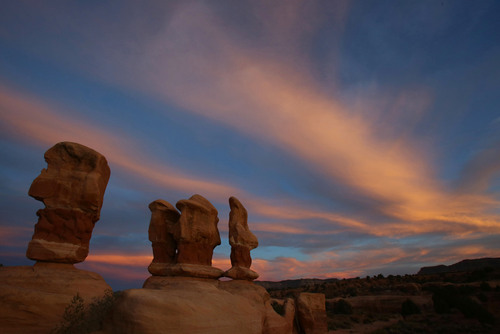This is an archived article that was published on sltrib.com in 2014, and information in the article may be outdated. It is provided only for personal research purposes and may not be reprinted.
National monuments declared by presidents under the Antiquities Act have become great assets to the states where they are located. Utah has four national parks that were first designated national monuments. The Beehive State's "Mighty Five" national parks, used as a slogan to lure tourists to Utah, would not exist if the decision to create them had been left to state or local officials.
That's why it's so important to protect the law giving presidents — of any political party — the power to protect lands with scenic or cultural significance with a "national monument" designation.
There is talk once again of a new Utah monument. Four areas have been named as possibilities: Greater Canyonlands near Moab, the San Rafael Swell in Emery County, Cedar Mesa area near Blanding and Desolation Canyon in eastern Utah.
Some believe President Obama is considering Greater Canyonlands for monument designation. As usual, such rumors cause an outcry from some local politicians about the loss of access to such outdoor treasures for industrial development.
Rep Rob Bishop sponsored a bill that passed the Republican-controlled U.S. House to limit any president's authority to create national monuments under the Antiquities Act.
That opposition fails to recognize the positive impact of such declarations: Think Grand Teton National Park and Grand Canyon National Park, both over the vehement objects of locals. And it runs counter to the interests, in this case, of the native people who were here long before the white settlers. Just south of Canyonlands National Park is a region sacred to the Navajo Nation, which has proposed congressional action to create the Diné Bikéyah National Conservation Area to protect the 1.9 million acres including Cedar Mesa in San Juan County from development.
But the Navajo have been largely ignored, so they now are asking President Obama to include the area in a national monument. While Bishop wants to give Congress veto power over presidential authority to set aside such lands, this case demonstrates just how wrong that would be.
The long-term economic future of Utah lies not in the traditional pursuits of mining, drilling and ranching, but in recreation. Tourist dollars pour into the state as visitors by the millions come to hike, bike and photograph our scenic wonders and support local businesses that accommodate them.
This kind of economic development is sustainable, not subject to the boom-and-bust cycles of mining and drilling. And it protects the land, its cultural significance, water and wildlife better than ranching.
President Obama should consider input from local residents and officials before invoking the Antiquities Act. Their ideas and concerns can be useful in creating boundaries for monuments. But local opposition or congressional inaction should not prevent a president from acting to protect the red rock vistas and antiquities that make Utah unique.



